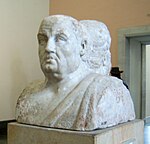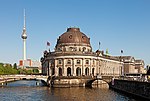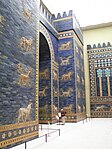Market Gate of Miletus
Antikensammlung BerlinArchaeological artifactsArchaeological discoveries in TurkeyMiletusPages containing links to subscription-only content ... and 1 more
Roman Anatolia

The Market Gate of Miletus (German: das Markttor von Milet) is a large marble monument in the Pergamon Museum in Berlin, Germany. It was built in Miletus in the 2nd century AD and destroyed in an earthquake in the 10th or 11th century. In the early 1900s, it was excavated by a German archeological team, rebuilt, and placed on display in the museum in Berlin. Only fragments had survived and reconstruction involved significant new material, a practice which generated criticism of the museum. The gate was damaged in World War II and underwent restoration in the 1950s. Further restoration work took place in the first decade of the 21st century.
Excerpt from the Wikipedia article Market Gate of Miletus (License: CC BY-SA 3.0, Authors, Images).Market Gate of Miletus
Platz der Märzrevolution, Berlin Mitte
Geographical coordinates (GPS) Address Website Nearby Places Show on map
Geographical coordinates (GPS)
| Latitude | Longitude |
|---|---|
| N 52.521 ° | E 13.396 ° |
Address
Museumsinsel
Platz der Märzrevolution
10117 Berlin, Mitte
Germany
Open on Google Maps









